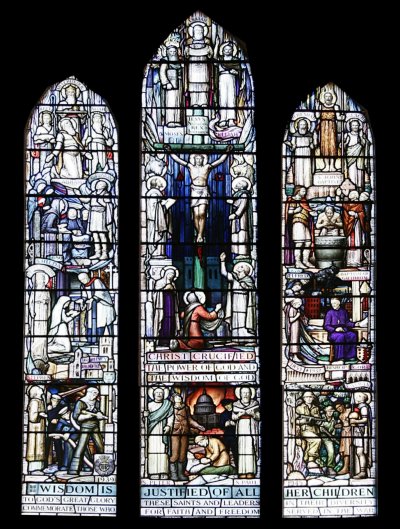|
The same passage appears, almost word for word, in Matthew 11:18-19. Maynard used only the King James translation of these passages, and generally interpreted the final sentence in terms of the variety of types of service rendered, by people from all walks of life, no matter how diverse their vocations.
And God is served in a great diversity of ways by high and low, rich and poor, learned and simple. He is served by the statesman, the scholar and teacher, the soldier and sailor, the doctor and the nurse, the builder and the carpenter, engineer, the poet and the musician, the mother and the nun.
... For this purpose we have selected representative saints and leaders in God's Church. Very different they are in their vocations, capacities, and the circumstances of their lives. Their very diversity may help us to remember that "Wisdom is justified of all her children." (Maynard, sermon of November 21, 1948.)
The text can, however, be interpreted slightly differently. Modern translations of Luke 7:35 tend to vary only in the translation of the word 'justified', so that the Jerusalem Bible, for example, renders this verse as: "Wisdom has been proved right by all her children."
But the translations of the parallel passage in Matthew are more varied, with different emphases. For example, the Revised Standard Version translates Mathew 11:19 as "Wisdom is justified by her deeds", and the Jerusalem Bible translates this same passage as "Wisdom has been proved right by her actions." Although the sense of a wide variety of people and situations has not been completely lost, the emphasis has shifted to the way in which we recognize that these people in their diversity are all "children of wisdom"; namely, by their deeds of service and sacrifice. Maynard was not unaware of this different emphasis. In the sermon quoted above, he also says:
All who fulfil their several avocations faithfully are wisdom's children. And no man can do better than "do his duty in that state of life unto which it shall please God to call him."
(This last quotation is from the Catechism in The Book of Common Prayer — Maynard used this quotation several times in his sermons on the window.)
Maynard is, then, using the different levels of meaning captured by his text — not only are wisdom's children diverse and varied in their circumstances and their service, it is also by the qualities of their example and service that we recognize them as "Wisdom's children".
Who, or what, then is 'Wisdom'? Maynard broaches this topic in the first of the sermons transcribed here, dated July 6, 1947. He returns to the question in the sermon preached on the day the window was dedicated, February 6, 1949, where he refers to the Wisdom Literature of the Apocrypha, and to the book of Job: "Behold, the fear of the Lord, that is wisdom; and to depart from evil is understanding." (Job 28:28.) But the central text for Maynard's understanding of Wisdom is from First Corinthians:
But we preach Christ crucified, unto the Jews a stumbling block, and unto the Greeks foolishness; but unto them which are called, both Jews and Greeks, Christ the power of God, and the wisdom of God. (1 Corinthians 1:23-24.)
This text is made the caption of the central panel of the central light of the window, and is clearly the context within which the rest of the window is to be interpreted: the focus from which the saints and leaders of the Church — in their varied vocations, capacities, and circumstances as represented in the rest of the window — are to be understood. As the overall caption to the window puts it:
Wisdom is justified of all her children.
To God's great glory, these saints and leaders, in their diversity,
commemorate those who, for faith and freedom, served in the war.
There is structure in this diversity. In the Australian Church Quarterly, Maynard writes:
The upper panels depict Old Testament Saints. The second panels, on either side, show scenes from early English Christian life. The third panels on either side represent figures of the two stages of the recent Catholic revival. The bottom panels represent, anonymously, the Navy, the Air-force and the Army. While in the centre of all there is "high and lifted up," the Crucified, revealing Himself to mankind as "the power of God and the wisdom of God." He shows through the cross the meaning and the opportunity of human life. (ACQ Vol. 14, No. 3: September 30, 1949.)
We explore some of these stories as we look at each panel of the window in turn in the following pages.
Last |
Index |
Next
|
